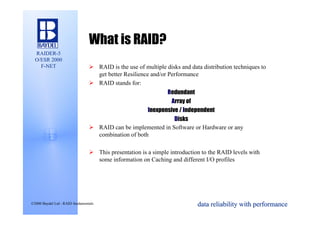Raid
- 1. What is RAID?
RAIDER-5
O/ESR 2000
F-NET Ø RAID is the use of multiple disks and data distribution techniques to
get better Resilience and/or Performance
Ø RAID stands for:
Redundant
Array of
Inexpensive / Independent
Disks
Ø RAID can be implemented in Software or Hardware or any
combination of both
Ø This presentation is a simple introduction to the RAID levels with
some information on Caching and different I/O profiles
©2000 Baydel Ltd - RAID fundamentals data reliability with performance
- 2. RAID0 - Striping
RAIDER-5
O/ESR 2000
F-NET Ø Simple striping of data across disks in the array
Ø No “RAID” resilience - if one disk fails, then the entire array fails
Ø Good for load balancing & elimination of “hot spindles”
Ø Usually implemented in conjunction with RAID1 to get resilience
Ø Array capacity = disk capacity x n where n is the number of disks in
the array
©2000 Baydel Ltd - RAID fundamentals data reliability with performance
- 3. RAID1 - Mirroring
RAIDER-5
O/ESR 2000
F-NET Ø Mirroring, shadowing, duplexing for resilience with 2nd copy of data
Ø Array capacity = disk capacity x n/2 where n is the number of disks in
the RAID1 set (or n/3 for triple mirroring)
Ø Can be used to mirror RAID0 RAID sets with other identical RAID0
sets (RAID01 or RAID0+1)
Ø Can enable simultaneous reads on both parts of mirror
©2000 Baydel Ltd - RAID fundamentals data reliability with performance
- 4. RAID3
RAIDER-5
O/ESR 2000
F-NET Ø Fine granularity data striping with ECC based disk redundancy
Ø Dedicated ECC disk (original definition)
Ø Highest throughput and simple write process
Ø Array Capacity = disk capacity x (n-1) where n is the number of disks
in the RAID set
©2000 Baydel Ltd - RAID fundamentals data reliability with performance
- 5. RAID5
RAIDER-5
O/ESR 2000
F-NET Ø Data striping with ECC based disk redundancy
Ø All disks have round-robin share of ECC data
Ø Good small block read I/O performance but complex write process
Ø Array Capacity = disk capacity x (n-1) where n is the number of disks
in the array
©2000 Baydel Ltd - RAID fundamentals data reliability with performance
- 6. RAID6
RAIDER-5
O/ESR 2000
F-NET Ø Same as RAID5 but with additional spindle and double ECC
redundancy
Ø Allows two disks to fail in the same RAID set
Ø Very complex write process
Ø Array capacity = disk capacity x (n-2) where n is the number of disks
in the array
©2000 Baydel Ltd - RAID fundamentals data reliability with performance
- 7. RAID Application Theory
RAIDER-5
O/ESR 2000
F-NET Ø The 1988 RAID paper came up with the following observations
(without any commercial RAID systems to prove or disprove and
without consideration for any enhancements such as caching)
Ø RAID5 was promoted as best for TP and database workloads
Ø RAID3 was considered best for scientific workloads
Ø Other applications fall between the two extremes in terms of
typical I/O size
©2000 Baydel Ltd - RAID fundamentals data reliability with performance
- 8. Using Cache to boost RAID5
RAIDER-5
O/ESR 2000
F-NET Ø Cache can be used to temporarily buffer write-data from the host to
allow faster I/O completion
Ø However, RAID5 requires lots of cache to overcome the basic
complexity of the write process. This reduces the amount of cache
available for write buffering and allows the cache to become saturated
in heavy load scenarios.
Ø Caching does not significantly boost throughput as small I/O’s benefit
most - large transfers are typically ignored by cache
Ø This means that RAID5 based systems can never be fully suited to the
entire range of applications
©2000 Baydel Ltd - RAID fundamentals data reliability with performance
- 9. Using Cache to boost RAID3
RAIDER-5
O/ESR 2000
F-NET Ø Just as with RAID5, cache can be used to buffer writes for fast I/O
completion
Ø Unlike RAID5, parallel RAID systems do not need to use cache to
overcome a complex write process
Ø This means that a much greater percentage of cache space is available
for genuine work and as a result a RAID3 system with cache is not
saturated as easily as an equivalent RAID5 system
Ø The extra cache space can also be used for hot read data
Ø Small I/O’s benefit most from caching, extending the suitability of a
RAID3 system with cache into the OLTP and DBMS range
©2000 Baydel Ltd - RAID fundamentals data reliability with performance
- 10. Summary
RAIDER-5
O/ESR 2000
F-NET Ø This presentation just covers the relationship between disks in the
basic RAID setups, and introduces the concept of caching.
Ø Data integrity issues are not covered
©2000 Baydel Ltd - RAID fundamentals data reliability with performance

